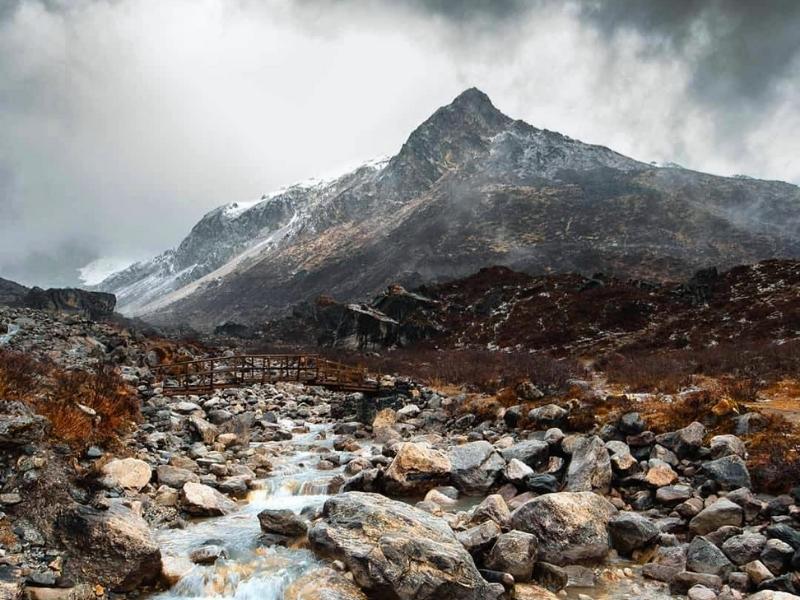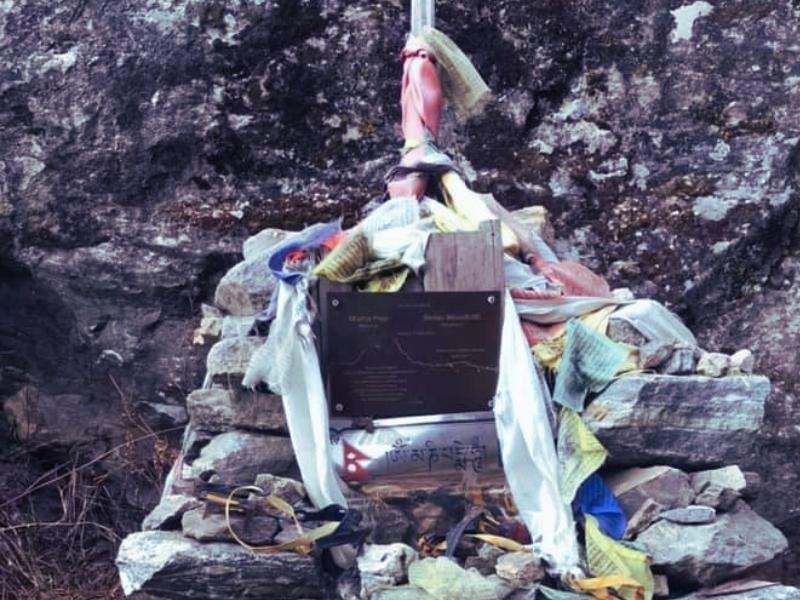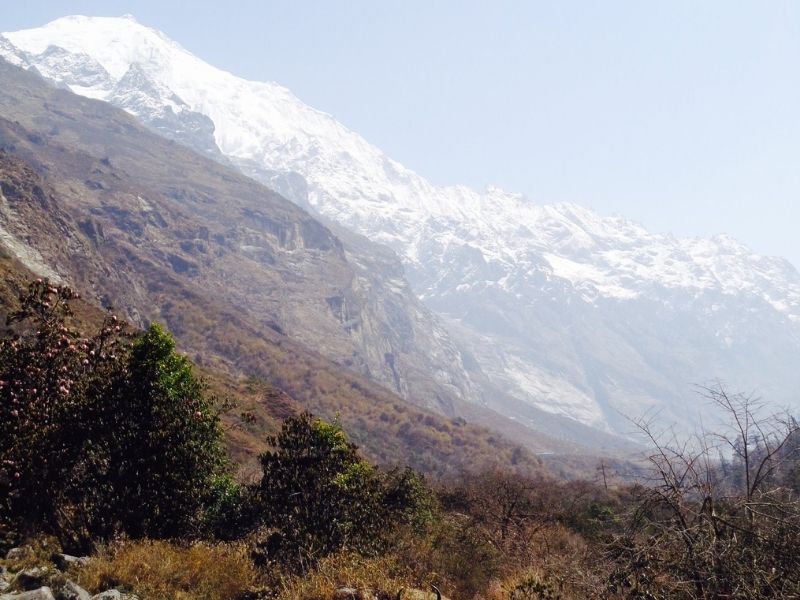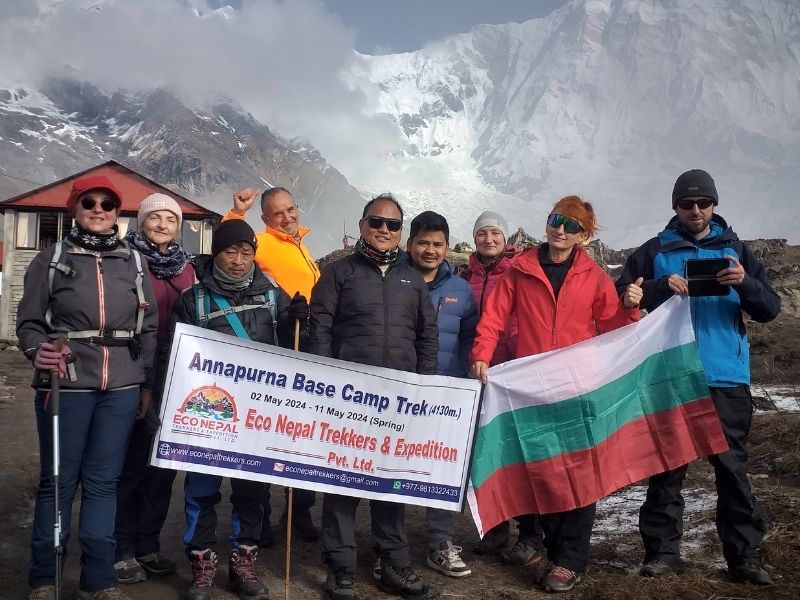On paper, 65 km of walking in the Langtang Valley Trek looks easy, but this is more difficult than one can assume.
As you move forward in the trek, the steep climbs, long days, and the thin mountain air all combine to test your stamina and determination.
However, there are also some regions, like Langtang village, where trekking is a little easier. Due to this combination of different trails, the Langtang Valley Trek is considered moderate in difficulty. That means it’s not as brutal as Everest Base Camp. But it’s also not a trek where you come around without any preparation.
So, in this blog, we are going into detail on how difficult this trek really is. Furthermore, we are going to tell you guys what kind of trouble you might have to go through each day of this trek.
Quick Overview of Langtang Valley Trek Difficulty
- Difficulty rating: Moderate (3/5)
- Total distance: 65 km (without side peaks)
- Duration: 6–8 trekking days (7–9 days including travel)
- Daily trekking time: 5–7 hours
- Maximum sleeping altitude: 3,870 m (Kyanjin Gompa)
- Maximum trekking altitude: 4,773 m (Kyanjin Ri) or 5,033 m (Tserko Ri – optional)
- Toughest parts: Day 2 (Lama Hotel to Langtang Village) and the side trip to Tserko Ri
What Makes The Langtang Valley Trek Difficult?
Initially, when trekkers hear that they only have to cover around 65 km, they assume this trek to be very easy. However, when they are actually on the journey, they realize things are actually a little different.
While interacting with them, we found some prime reasons increasing the difficulty of this journey. In fact, when we interacted about the Tamang Heritage Trail trek, the difficulty level they faced during the trek was also somewhat similar.
Quick Altitude Change
The trek in itself begins from Syabrubesi at 1550m. From there, you climb all the way up to Kyanjin Gompa at 3,870m. The elevation gain of 2320m often increases the risk of altitude sickness. Additionally, while trying to cover it in a quick time, most of the trekkers experience symptoms like headache, fatigue, and loss of appetite.
Distance and Walking Hours
Each day of this trek, you will walk for around 5 to 7 hours. Some stretches are short, but some can be as long as 21km (from Kyanjin Gompa to Lama Hotel). This sometimes puts pressurize on your knees, which increases the level of difficulty.

Langtang Valley’s Varied Terrain
Not all regions have the same terrain. While some terrains are open and wide but others are steep and rocky. Let’s be honest here, this is what makes this trek exciting, but one can’t deny that it’s also one of the challenging factors.
Unpredictable Weather and Seasonal Changes
In the best season, like Autumn, you will be able to travel this area quite easily. But, besides that season, the weather is always unpredictable. Due to the monsoon, you will get muddy and slippery trails. While in winter, you will find snow that throws your gears. In fact, only a handful of people are available to reach Tserko Ri in winter.
Your Physical Fitness
The other important factor that can increase your difficulty is your physical fitness. If you are physically fit, this trek becomes a piece of cake. However, if you are dealing with some underlying medical condition, the whole journey becomes hellish. Besides that, if you haven’t gone trekking, your stamina might be a little low. So, before planning for this trek, we advise you to do some exercise.
Langtang Valley Trek Day By Day Difficulty Breakdown:
Some days in this trek are easy, and some days are really tough. In this breakdown, we have assumed that you will be going to both Kyanjin Ri and Tserko Ri. Now, without any further ado, let’s get into the day’s difficulty.
| Day | Difficulty Rating |
| Day 1: Syabrubesi to Lama Hotel | 3/5 |
| Day 2: Lama Hotel to Langtang Village | 4/5 |
| Day 3: Langtang Village to Kyanjin Gompa | 2/5 |
| Day 4: Kyanjin Gompa to Kyanjin Ri, and return | 4/5 |
| Day 5: Kyanjin Gompa to Tserko Ri and return | 5/5 |
| Day 6: Kyanjin Gompa to Lama Hotel and | 3/5 |
| Day 7: Lama Hotel to Syabrubesi | 2/5 |
Day 1: Syabrubesi to Lama Hotel
The first day already feels heavy because you’ll be climbing almost the entire way. In just 11.3 km, you gain 830 meters in elevation. The humidity in the forest and the continuous uphill make this day more tiring than it looks on paper.
Furthermore, there are very few flat sections. The uphill is mostly continuous. Many trekkers even describe this day as an “endless staircase”.
In fact, most beginners find themselves gasping by the time they reach Lama Hotel.
Besides that, during the time of monsoon, the slippery patches add an extra layer of difficulty to this day.
Difficulty Rating: 3/5
Day 2: Lama Hotel to Langtang Village
Day 2 is when most trekkers realize this trek is not that easy. You have to cover 14.8 km while gaining 1050 meters in altitude. What makes it harder is that you’ll be crossing 3,000 meters for the first time.
In fact, as per the NHS, altitude sickness usually starts at over 2500m. On day 2, you will be reaching till 3430m,so altitude sickness symptoms like headache or shortness of breath can start appearing.
Additionally, the trail is also rocky and uneven. You will be climbing uphill all day. Furthermore, during rainy days, leeches rule this trail. Many trekkers even call this day “the leech day”.
So, even when the distance isn’t extreme, this combination of distance, steep ascent, and thinner air makes Day 2 one of the toughest.
Difficulty Rating: 4/5

Day 3: Langtang Village to Kyanjin Gompa
Compared to the first two days, this one feels almost relaxing. You’ll only walk about 6.8 km and climb around 400 meters. The terrain is not very steep compared to previous days.
But don’t underestimate it – at close to 4,000 meters, the thinner air makes the body slower.
If someone rushed the first two days without acclimatizing well, symptoms of AMS can appear here. Still, this is the easiest stretch of the trek and gives you a much-needed break.
Difficulty Rating: 2/5
Day 4: Kyanjin Gompa to Kyanjin Ri and return
The climb to Kyanjin Ri looks short on the map, but don’t be fooled. In just a few kilometers, you gain almost 900 meters in altitude. The trail is steep, with zig-zags that get sharper as you move higher.
Furthermore, at nearly 4,800 meters, the lack of oxygen makes every step heavy. If you trek in late autumn, winter, or early spring, snow adds another layer of challenge. Icy sections around the upper slopes make the climb slippery. The honest truth i,s sometimes you’ll need microspikes or extreme caution just to get a good footing. Many trekkers say that the combination of thin air and icy terrain makes Kyanjin Ri much harder than they expected.
Difficulty Rating: 4/5
Day 5: Kyanjin Gompa to Tserko Ri and return
This is, without question, the hardest day of the Langtang Valley Trek. You’re climbing 1,450 meters in one push, all the way above 5,000 meters, and spending six to eight hours on your feet. The steepness, the rocky zig-zags, and the thin air are already brutal, but add snow, and it becomes a whole new level of difficulty.

In winter and early spring, the trail to Tserko Ri is often covered in snow and ice, making it harder to follow and more tiring on the legs. Some trekkers turn back halfway because the snow cover makes the climb much slower and riskier. Those who push through often say that the snow-capped peaks surrounding them are breathtaking, but they also agree this day is the single toughest of the whole trek.
Difficulty Rating: 5/5
Day 6: Kyanjin Gompa to Lama Hotel
On the way back, the descent looks easy on paper, but it’s 21 km in a single day. Losing more than 1,500 meters of altitude puts enormous pressure on the knees. By evening, most trekkers are more exhausted from going down than they were climbing up.
Difficulty Rating: 3/5
Day 7: Lama Hotel to Syabrubesi
The final stretch is about 11 km downhill. Compared to the previous days, this feels much easier, but your body will already be fatigued after nearly a week of trekking. Even though it’s not technically tough, the accumulated tiredness makes you feel every step until you finally reach Syabrubesi.
Difficulty Rating: 2/5
However, with an aim to make this challenging journey fun, we have made the 11 day Langtang Valley Trek package where we included acclimatization day. The acclimatization day decreases AMS risk by half.
Altitude Sickness Experience of Our Trekkers In Langtang Valley Trek
One of the most common struggles trekkers report in Langtang Valley is altitude sickness. The problem is not that the trek goes extremely high ( Kyanjin Gompa is “only” at 3,870m) but the fact that the altitude gain is very quick. In just two days, you jump from 1,550m to over 3,400m. That sudden rise is what catches beginners off guard.
While interacting, our trekkers have shared how they reached Langtang Village with headaches, dizziness, or a complete loss of appetite.
Some even admitted they could hardly sleep because of shortness of breath. Furthermore, they unanimously said:
If you are a slow acclimatizer, the standard pace can actually feel punishing. The real kicker comes when you attempt Kyanjin Ri or Tserko Ri. Above 4,700m and 5,000m, the air pressure is almost half of what you breathe at sea level. Even short steps feel like climbing with a heavy weight.
So, this is why many people say the Langtang Valley Trek may be “moderate” overall, but the altitude factor alone can flip the difficulty scale quickly if you don’t take it seriously.
By the way if you are a seasoned trekkers and looking for the best possible itenarary, you can read our Langtang Valley Trek 5 Days blog.
Seasonal Difficulty In the Langtang Valley Trek
The season you choose for Langtang Valley can completely change how difficult the trek feels. Autumn and Spring are the most forgiving, with dry trails, stable weather, and crisp mountain views. Most people complete the trek in this season without facing major obstacles. Monsoon, however, is a different story.
Between June and early September, forest sections below 2,500m are crawling with leeches. In fact, some trekkers call Day 2 “the leech day” because they find them clinging to shoes, socks, and even inside clothing. Add to that the landslide-prone slopes and muddy, slippery staircases, and suddenly the same trek becomes double the difficulty.

Winter is equally brutal, but in another way. Snow covers the trails above Langtang Village, and the summit climbs are often buried under ice.
Some trekkers have shared that they needed crampons for Tserko Ri in January. Even descents in winter are punishing because frozen ground puts extra stress on the knees. In short, autumn and spring make this trek moderate, but monsoon and winter can make it extremely hard.
Terrain and Trail Challenges
Another thing that defines the Langtang Valley Trek difficulty is the trail itself. Unlike Annapurna Base Camp, where most of the paths are paved with stone steps, Langtang trails are wild and unmanaged.
In the lower sections, the problem is continuous forest climbs that feel like endless staircases. Higher up, the path turns rocky and uneven, and sometimes you are scrambling across scree or old landslide debris.
In fact many of the trekkers we guided described the upper Langtang trails as “giant rocky staircases.” One hiker even said walking there felt like balancing on loose gravel for hours. The summit hikes to Kyanjin Ri and Tserko Ri are particularly technical, with zig-zags carved into steep, rocky ridges. And since there are no structured steps like in Annapurna, the strain on your ankles and knees is much higher. This rough terrain is one of the biggest reasons why Langtang is harder than many people expect.
Now after knowing all this difficulty, you must be thinking what’s the safest and easiest way. Well, check out our Langtang Valley 6 Day With Helicopter Return package. It’s safe. It’s fast and It’s easy.
Langtang vs Annapurna Base Camp vs Everest Base Camp
So, where does Langtang Valley sit compared to the famous treks of Nepal? From the research we did, trekkers consistently rank Langtang as tougher than Annapurna Base Camp but far easier than Everest Base Camp.

The reason it’s harder than ABC is simple: the trails are rougher, steeper, and less managed. ABC may be longer in distance, but its paths are structured, and the ascent is more gradual. On the other hand, Everest Base Camp pushes you much higher, with the base camp itself at 5,364m. The air is thinner, the days are longer, and the weather is harsher. Langtang never gets that extreme. This is why many call Langtang the “middle ground trek” — a step up from Annapurna, but not as punishing as Everest.
Who Should Attempt Langtang Trek?
Langtang Valley Trek difficulty is rated moderate, but that doesn’t mean it’s for everyone. If you have decent fitness and some hiking experience, this trek is very achievable. Even beginners can attempt it, but they need to be ready for 6–7 hours of daily walking and the altitude risk.
This trek is not recommended if you have knee problems or breathing issues that get worse at altitude. Trekkers who are impatient or try to rush the pace often regret it halfway, especially on the climb to Langtang Village and the side trip to Tserko Ri. But if you’re the kind of person who enjoys a challenge and can push through tired legs, this trek rewards you more than most.
Preparing for the Difficulty
The easiest way to make Langtang Valley feel less difficult is preparation. Trekkers who train with cardio and uphill walking before arriving in Nepal always say the trek felt easier than they expected. Carrying trekking poles is another small step that saves your knees during the long descents. Drinking plenty of water each day also makes a huge difference at altitude.
Most importantly, don’t underestimate the mental side. Trekking for a week straight, with long uphill climbs and thin air, will test your patience as much as your muscles. The people who complete Langtang without much trouble are the ones who take it slow, enjoy the journey, and accept that some days will feel harder than others.
The other thing that one most consider before going on a trek is cost. So, we have prepared a blog for you where we have the calculation from Flight to accomodation budget. Read our Langtang Valley Trek Cost, to know in detail.
Our Final Say on Langtang Valley Trek Difficulty
So, how difficult is the Langtang Valley Trek? The answer is: it’s moderate, but that word doesn’t tell the full story. It’s a trek of contrasts; steep forest climbs followed by wide-open meadows, manageable days followed by brutal summit pushes, easy stretches followed by long knee-breaking descents.
For most trekkers, the hardest points are the climb to Langtang Village and the side trip to Tserko Ri. But with preparation and the right mindset, every single part is achievable.
Langtang Valley is not as easy as it looks on paper, but it is also not out of reach. It sits in the sweet spot: harder than Annapurna, easier than Everest, and just challenging enough to leave you with a sense of achievement. If you’re ready to test your endurance against altitude, rocky trails, and long days, then this trek will give you one of the most rewarding experiences in the Himalayas.

